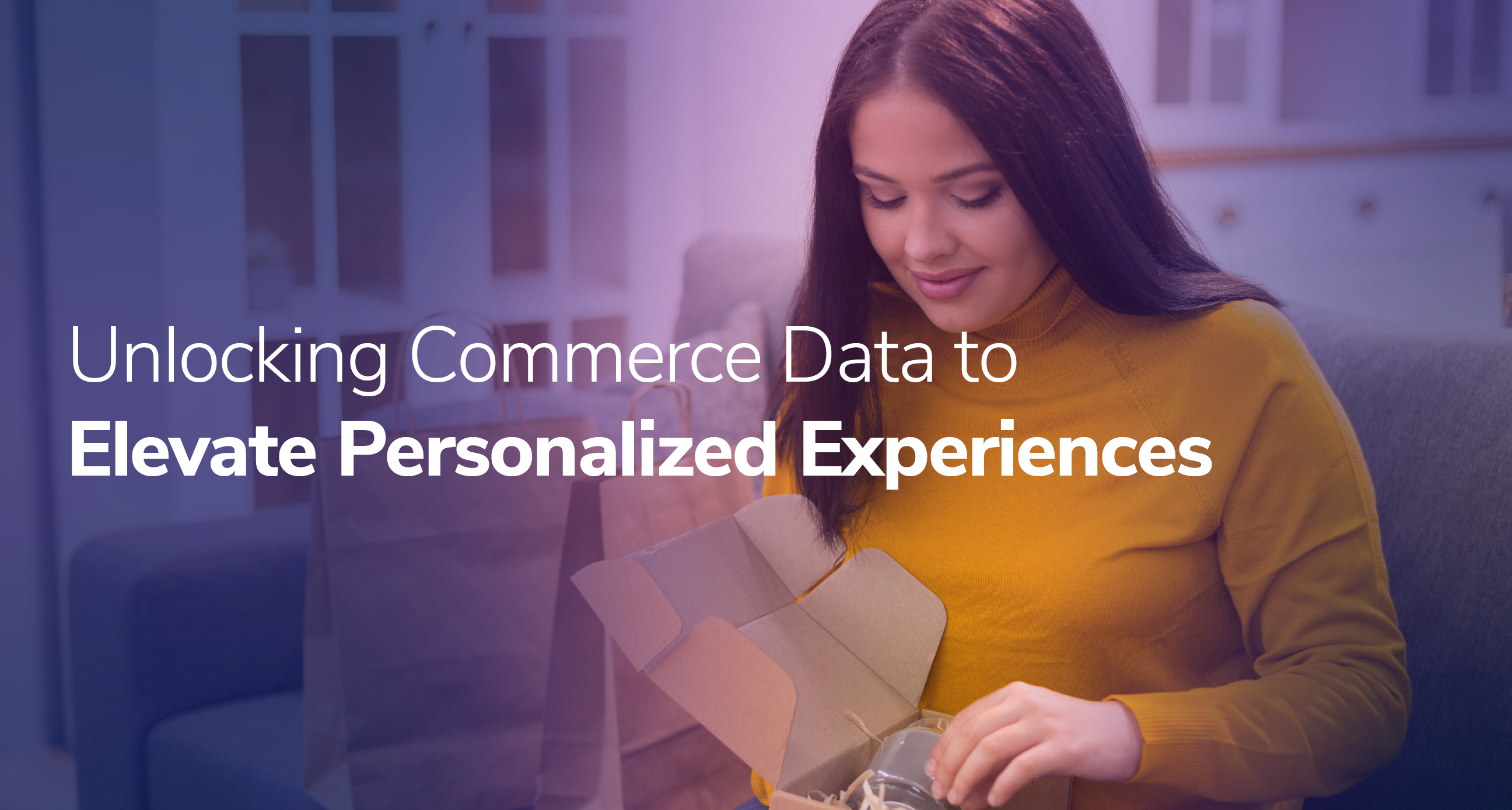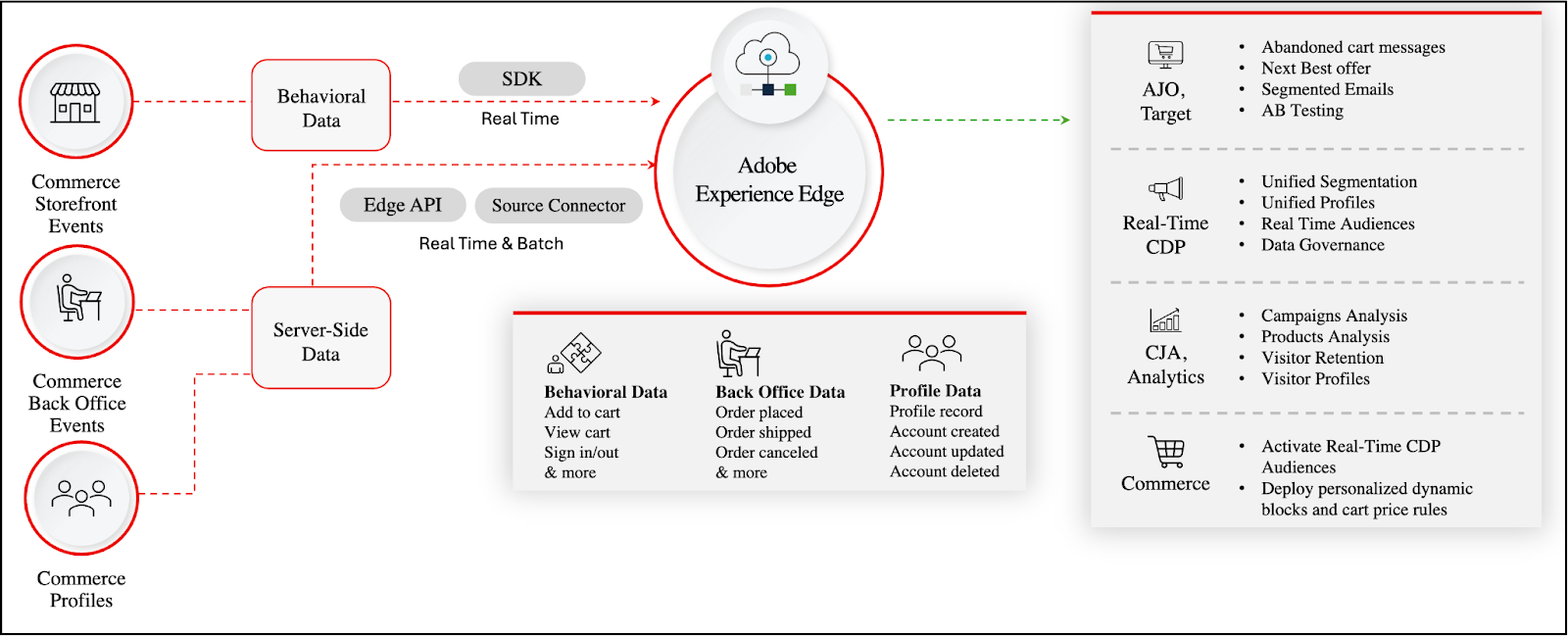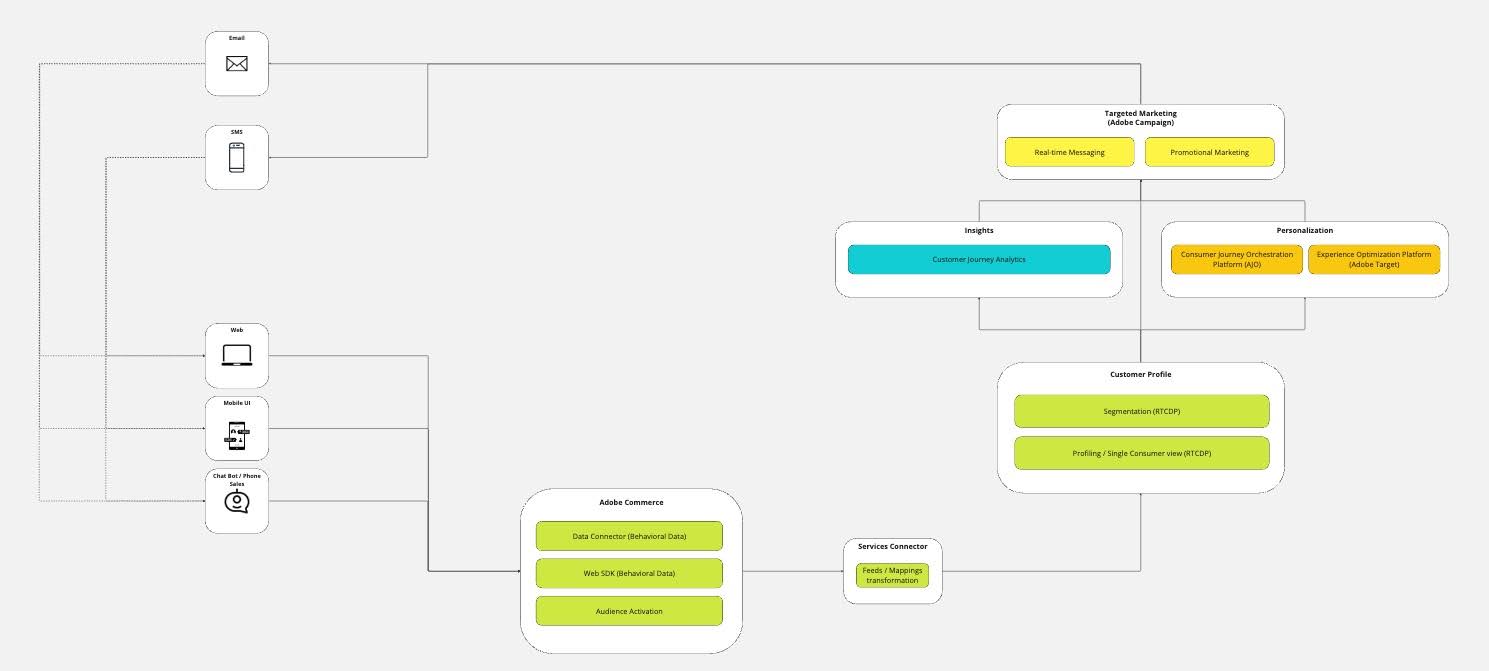Unlock Commerce Data to Elevate Personalized Experiences

One of the major trends in the post-Covid consumer packaged goods market is hyper-personalization. Across industries, brands are prioritizing the digital sophistication of their personalized engagement tactics to achieve customer loyalty and improved customer lifetime value (LTV).
According to Insider Intelligence, 73% of customers expect companies to understand their unique needs and expectations and deliver experiences that fulfill them. Executing the personalization tactics that fulfill these expectations, however, is no small endeavor.
According to Forrester’s 2023 Future Fit survey, 67% of business and technology decision-makers are in the process of adopting data capabilities to build/improve a complete view of their customer across channels. However, the top challenge among respondents is understanding the data (18%,) and close behind is an inability to process big data and act on it at the speed needed by operations, business, and customers (17%).
A good personalization strategy must consider several factors to make sure the solution meets the business and customer needs:
Security: Dealing with customer data means that the solution needs to be in compliance with a country's laws and regulations, as well as uphold strong measures for data protection and management.
Meaningful customer value: “People also buy with” or “You may also like,” widgets or offers only scratch the surface of personalization and often do not provide sufficient value to customers. Understanding what the customer has bought, seen, compared, and even returned will give your offers a better chance to captivate consumer attention. One example of personalization done wrong is sending a discount offer for a product that the customer has already purchased at full price. This could lead the customer to reconsider buying again, stalling their purchase to see if the product goes into discount at a later date. Instead, a good personalization solution will offer the customer products that may complement other products they may have already purchased.
Data availability: It is of no use to collect data if it will require several days, weeks, or even months for the marketing team to analyze and activate that data into possible offers and campaigns. Good personalization solutions require data to be readily available and digested for the marketing team to take action. Based on the analyzed data, real-time availability will make the difference in setting precise campaign rules and even ad spending efficiency.
Increased Efficiency: A good personalization solution should provide the data clarity and actionability needed to allow business and marketing teams to generate customer profiles, campaigns, offers, and data analysis faster.
Creating the right personalization strategy for a business has several benefits, such as:
- Increased Revenue: Companies that excel at personalization generate 40% more revenue from those activities than average players (McKinsey).
- Increased Conversion and Average Order Value (AOV): Business growth by 11% from increasing the audience, conversions, and order value (Forrester). 80% of shoppers are more likely to buy from a company that offers personalized experiences (Epsilon).
- Increased Loyalty: More than half (54%) of marketers worldwide reported better brand engagement because of increased personalization efforts (Insider Intelligence).
Leveraging the Adobe Commerce Data Connection for Behavioral Data Insights
While Adobe Experience Platform (AEP) helps you deliver hyper-personalization at scale by creating a 360-degree view of your customers, its success relies heavily on clean, reliable, and precise commerce and web behavioral data. With the Data Connection Module, you can now leverage Adobe Commerce as a single source of truth to capture and enhance commerce and behavioral data in AEP, enabling their activation through Adobe Real-Time CDP (RT-CDP).
The Data Connection module allows Adobe Commerce to send three types of data, Storefront Events, Back Office Events, and Profile Data to the Adobe Experience Platform Edge Network. Keep in mind that the Data Connection module only leverages out-of-the-box Adobe Commerce entities and attributes. Adobe Commerce's popularity has always been around its malleability, and more often than not, businesses have enhancements around sales and product entities. For this reason, it may be that certain modifications are required; however, that should not be an impediment to a well-thought-out personalization solution.

Storefront Events
Storefront events capture consumer interactions on the site (page views, product views, cart actions, order placements) that occur within an Adobe Commerce store. While you can capture these events through traditional webSDK implementation, there are added advantages for ingesting them through the Adobe Commerce connector. Depending on the publishing method (discussed below), you should at least get:
- Accelerated Time to Market: By automatically populating the data layer, Adobe Commerce streamlines the process, eliminating the need for web development efforts to push data into the Adobe Client Data Layer (ACDL). This alone is a compelling reason to adopt the Adobe Commerce approach.
- Enhanced Reliability and Reduced Maintenance Effort: Although quality assurance (QA) remains important, the reliability and quality of data pushed into the ACDL is notably high. Moreover, Adobe Commerce assumes the responsibility of maintaining the data layer, allowing you to focus on optimizing and enhancing your commerce store and customer experience.
Leveraging the Adobe Experience Platform Web SDK (Alloy), as well as the Adobe Commerce Events SDK, the connector can be used to expose and contextualize data from Adobe Commerce. The contextualized storefront events can be published to AEP Edge (for data ingestion) in two different ways that come with their own pros and cons:
- Direct Publishing: Through this approach, the Data Connection Module harnesses the Adobe Commerce Event Collector to seamlessly convert ACDL data into an Experience Data Model (XDM) object, utilizing out-of-the-box implementation. In essence, the connector autonomously populates the data layer, deploys the webSDK, collects and transforms data into XDM format, and dispatches it to AEP, all without any manual intervention. Although it utilizes web SDK, there's no prerequisite for Adobe Tags to be in place.
- Customized Web SDK Publishing: In scenarios where additional website data transmission is necessary, as is often the case, the connector can be customized to solely populate the data layer. Subsequently, you can employ Adobe Tags to deploy webSDK, encapsulate the data into XDM, and initiate a sendEvent call to AEP Edge. While this method demands more effort, it stands as a more adaptable and scalable approach to implementation.
Back Office Events
Back Office events capture data from the order process flow, such as changes in order status (placed, invoiced, shipped, complete, canceled), enabling a 360-degree view of the shopper’s ordering journey. This view helps merchants better target and analyze the entire customer order history when developing marketing campaigns, thus giving personalized offers that make sense to the customer (remember the case of offering the same product a customer already purchased but now with a discounted price). All user identifiers, such as cookie IDs and IP addresses, are strictly anonymized.
As long as an order is created in Adobe Commerce, the order data will also flow to the Experience edge; for that reason, it will not require integrating with other channels like mobile applications, chatbots, sales through call centers, or even if you send offline data (brick and mortar) to Adobe Commerce. The back office will also send the data to AEP. This enables a single point of entry for data into the Experience Edge.
Helping The Coca-Cola Company Make the Most of Their Adobe Stack
The Coca-Cola en Tu Hogar MarTech team, Bounteous, and Adobe joined forces for one of the first integrations of Adobe Commerce to Adobe Experience Platform using Data Connection. During the project, collaboration was key to achieving a successful flow of commerce and behavioral data from Adobe Commerce.
We partnered with the Coca-Cola en Tu Hogar MarTech team to define and refine the use cases that they needed to activate upon in their LATAM region. The use cases ranged from tracking subscription orders and targeting cart abandoners to identifying upsell and cross-sell opportunities across Coca-Cola brands. Once the use cases were defined, the next step was to determine the data requirements to ensure that Coca-Cola en Tu Hogar can realize value from its investment in Adobe Experience Platform (AEP) products and services. A number of business-specific data points like subscription_flag, purchase_frequency, bottler_ID, customer_ID, etc. were identified that were not part of the out-of-the-box solution.
At this point, it became evident that customization was needed across their storefront and back-office data to enhance the Data Connection module to allow the flow of additional data points unique to the LATAM region and their Adobe Commerce implementation.
Multiple teams at Bounteous spanning Commerce, Analytics, and CDP expertise came together to execute this integration. As the CDP team prepared the AEP platform for seamless data ingestion via custom XDMs, Bounteous's Adobe Commerce team partnered closely with the Adobe Engineering team to meticulously map custom back-office data flows from Commerce into the Commerce Services Connector (SaaS) to ensure accurate ingestion into AEP Edge while maintaining data integrity. Simultaneously, Bounteous's Analytics team executed a flawless implementation of storefront events, incorporating custom data points and identities through Adobe Tags and web SDK.
One notable challenge involved integrating Coca-Cola en Tu Hogar’s identity provider with the commerce data collected via the connector while adhering rigorously to data security and governance policies. Bounteous solved this challenge by streamlining identity strategy across the data sources and ensuring that the platform is ready for Customer Journey Analytics (CJA) when it is integrated in the future.
If you'd like to learn more about the strategy, analysis, and impact of this implementation, join us at our Adobe Summit 2024 speaking session, “Coca-Cola: Unlocking Data To Create Consumer-Centric Commerce Experiences.” Our team will delve into our blueprint for value realization with Adobe’s Real-Time CDP/Commerce and our journey with Adobe and The Coca-Cola Company.
How Adobe Stack Architecture Helps Drive Personalization
Through the full integration of the Adobe Experience Cloud stack, users can unlock lower time to market and the ability to train marketing teams in just one suite of tools instead of needing expertise across several platforms and solutions.
Adobe Real-Time CDP (RTCDP): Allows the creation of unified customer profiles from data collected across channels. Data governance frameworks allow easy generation and management of data compliance policies to ensure customer data is accessible only to the right roles and honors consumer preferences by channel adhering to data subject rights as outlined by GDPR.
Adobe Journey Optimizer (AJO): Lets users manage inbound customer engagement and outbound omnichannel campaigns using real-time insights and AI-driven workflows, engaging one customer or millions anytime, anywhere. Through Target integrate A/B testing without frontend or theme customization in Adobe Commerce.
Customer Journey Analytics (CJA): Offers an end-to-end customer journey visualization, enabling analysts to conduct deep exploratory analysis at the customer level for even further audience segmentation, apply AI insights to further optimize segmentation, and improve objective attribution.
Brands can leverage data insights rendered by CJA to inform how, when, and where they reach out to customers. This helps marketing departments make better-informed decisions on the platforms and channels they choose for their messaging, which in turn helps maximize their ad spending efficiency.
According to Forrester’s The Total Economic Impact™ Of Adobe Real-Time Customer Data Platform, Journey Optimizer, And Customer Journey Analytics report, companies that utilized the Adobe Experience Cloud platform saw a 200% increase in reach with personalized messaging, as well as an improvement of 10% in the time that their marketing teams took to generate campaigns and apply insight to it within the first year of implementation, and a 20% of improved efficiency after two and three years of the implementation.
In addition, companies that implemented AEC (Adobe Experience Cloud) saw an increase in conversion rates of 5% in year one and 10% in year three. AOV saw an increase of 3% in Year one and 5% in Year three.

Even in this fluctuating economy, businesses are determined to invest and explore the potential that hyper-personalization can unlock for their brand. For this reason, it is important to understand your unique business requirements and the specific data insights needed to execute successful customer-centric experiences.